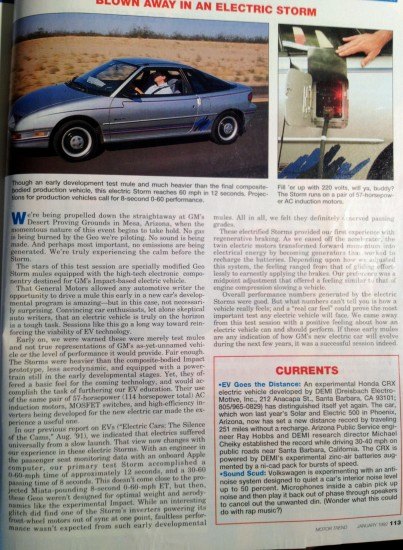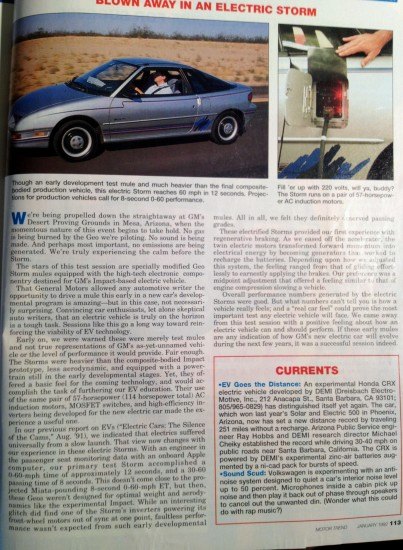Geo Storm EV Mule, The Chevrolet Volt's Baby Daddy?
While on the Infiniti JX launch event, I met a gentleman who now works with Nissan. He had a number of interesting stories about his tenure at GM, and what it was like to work on the EV1 program, as well as the technology that he swears was the forerunner to the Chevrolet Volt.
According to him, GM engineers in 1991 needed a way to keep the batteries in their GM Storm EV mules charged. A crude range extender was fashioned out of a Honda generator, which would kick in when the batteries dropped below a certain point.
The Storm mules were gutted and filled with batteries and a generator and driven around during development. He swears that, with the number of EV1 and Impact (the original GM EV) people left kicking around for the Volt’s development, the range extender idea must have lived on in someone’s mind for a very long time, until it came time to put it in operation.
I begged him to grant me an interview, or at least let me quote him, but he wouldn’t indulge me. I was left wondering about the early days of the program, until I stumbled upon this article in the January 1992 edition of Motor Trend. The big difference here is that GM has ditched the range extender and worked out a proper 220V charging system (apparently that was an obstacle in the early days). Note that the EV1 charging paddle is absent here, and it seems to use a very-1990s flashing LED charge port, similar to the L.A. Gear running shoes that were found to have mercury in them.
Since there seems to be a fair amount of Storm love on TTAC these days, it’s worth recognizing the irony of a largely forgotten car paving the way for perhaps the biggest automotive lightning rod since the Edsel.
You can see the full-size scan in the gallery below
More by Derek Kreindler
Latest Car Reviews
Read moreLatest Product Reviews
Read moreRecent Comments
- Kwik_Shift_Pro4X I've mentioned before about being very underwhelmed by the Hornet for a $50000+ all in price tag. Just wasn't for me. I'd prefer a Mazda CX-5 or even a Rogue.
- MaintenanceCosts Other sources seem to think that the "electric Highlander" will be built on TNGA and that the other 3-row will be on an all-new EV-specific platform. In that case, why bother building the first one at all?
- THX1136 Two thoughts as I read through the article. 1) I really like the fins on this compared to the others. For me this is a jet while the others were propeller driven craft in appearance.2) The mention of the wider whitewalls brought to mind a vague memory. After the wider version fell out of favor I seem to remember that one could buy add-on wide whitewalls only that fit on top of the tire so the older look could be maintained. I remember they would look relatively okay until the add-on would start to ripple and bow out indicating their exact nature. Thanks for the write up, Corey. Looking forward to what's next.
- Analoggrotto It's bad enough we have to read your endless Hyundai Kia Genesis shilling, we don't want to hear actually it too. We spend good money on speakers, headphones and amplifiers!
- Redapple2 Worthy of a book




































Comments
Join the conversation
Around the same time, GM's Electro Motive Division was succesfully replacing the DC motors in locomotives with AC-induction motors. The latter motors are lighter, cheaper and essentially maintenance free. Of course to power an AC motor requires a far more complex electronic brain which drive an equally substantial electronic power train...no small feat in the early 90s! I wonder how much of EMD's expertise was used by Chevrolet? Of course in locomotives, the power devices were either thyristors or IGBTs, whereas on a car you had to use the smaller and less expensive Mosfets.
Sometimes, I wonder what would have happened if GM had not killed off the EV1 program. Would we have something far more advanced than the Volt at this point? I doubt it due to two important factors: 1. The price of gas. Periods of stable gas prices interrupted by short bursts of rising gas prices. Eventually, they stabilize. 2. Battery technology The battery technology available back then was not as powerful or efficient as what we have now. Even so, current technology must evolve at a rapider rate to keep up with the demands of the marketplace. I wish you could have gotten that interview as well. I'm wondering if this person was sworn to secrecy past a certain point?